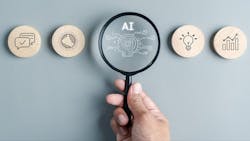10 trends for how artificial intelligence is changing the face of industry
In many ways, the future of artificial intelligence (AI) will be as humankind’s partner. In manufacturing, this partner, or copilot, can speed up or take over certain tasks to improve workers’ ability to do their jobs or different tasks altogether. Ultimately, AI will become a partner in the decision-making process, with the ability to analyze much larger amounts of data than a human ever could. This hybrid intelligence is a combination of human intelligence with artificial augmented intelligence, says Artem Kroupenev, vice president of strategy at Augury.
Plant Services talked with Kroupenev about how this AI copilot will change the face of industry and what’s next for AI-enhanced manufacturing. Here are some trends highlighting how AI will influence the future architecture of the industrial enterprise.
1. Reliability engineering paradigm shift
This paradigm shift is one that’s already happening, and the future for AI-enhanced predictive maintenance will only grow. “It’s a major paradigm shift for the way we think about reliability engineering. Once you have machine monitoring that’s driven by AI, it’s incredibly difficult to go back to more traditional methods. For a lot of our customers that has now become table stakes,” Kroupenev says. “[The use of AI] changes the paradigm of what reliability is or the way you think about maintenance, so you can effectively move from a time-based approach, or an approach that estimates what needs to be done around pieces of machinery, to actually knowing for every single piece of equipment, what exactly is happening way ahead of time.”
2. New technology to attract a younger workforce
Manufacturing has long struggled to attract new and younger talent, often inhibited by the dark and dirty image of industry. Technology is helping to change that image and changing the nature of manufacturing work. “It’s actually easier for manufacturers, in some cases, to attract talent for the workforce because the nature of the work becomes different. It moves from constantly firefighting, trying to figure out what machines might fail and constantly being disappointed with not doing enough to avoid these failures, to having a very strong sense of control and being able to then perform a much higher order of functions, in order to plan your reliability and maintenance much better and learn much faster,” he says.
3. Smarter and smarter prescriptive diagnostics
Aggregated data across different machines in different industries can constantly improve the quality and accuracy of algorithms, and machine learning is a cumulative and exponential process. With enough data and the accuracy that comes with that, predictive maintenance can come with guarantees. With Augury’s AI system, if it misses a failure, Augury will pay for repairs to replace that equipment. “It’s not just detection, it’s also prescriptive diagnostics, way ahead of time. We’ve already amassed a good amount of data in order to make sure that the accuracy is incredibly high, to the extent that our customers can rely on that, and we can actually guarantee it,” Kroupenev says.
4. AI-enabled equipment and increased data value to OEMs
Augury is working with original equipment manufacturers (OEMs) to embed its AI technology into the machines during design. More and more, this makes AI table stakes for end users.
Most AI applications are retrofitted to older machines, and that will become more and more cost effective as technologies progress. “A lot of the new equipment will come with sensing and the right type of data infrastructure embedded into those machines,” Kroupenev says. Also, many OEMs do not have a view into their equipment in the wild, which can be useful to user and builder. “The equipment manufacturers can utilize some of the statistics that we have anonymized in order to improve the reliability of the equipment that they design and service,” he adds.
5. Less hierarchy architecture, more network
Traditionally, software applications are built like pyramids with an hierarchy of solutions (to collect, store and analyze data, including hardware and software). This layered systems approach is often slow to build, scale, or update. Instead, AI and cloud infrastructure have helped enable software-as-a-service, predictive-maintenance-as-a-service, and AI-as-a-service, which means manufacturers no longer need that monolith architecture. Industry has a lot of legacy equipment, and it’s difficult to rip and replace everything, so it will take some time, Kroupenev says. But beyond legacy, AI will rapidly change the landscape. “I think the future architecture is less hierarchy and more of a network of solutions that are enabled by connected cloud architecture,” he adds.
6. Wide and sweeping generative AI applications
The initial narrow applications of AI looking at ERP data, machine or process signals, or quality data is incredibly useful for these specific applications, but generative AI (Gen AI) adds another layer. “What Gen AI does is it understands the wider context of human language and the way that organizations operate, and the way that each specific company operates,” Kroupenev says. “There are also older conversations, emails, briefings, proposals, legal contracts, customer conversations. All that data that happens within the company. That is human language data that is beyond the numbers. Now you have not only copilots in terms of reliability, or machine diagnostics or process optimization, you also have a copilot that serves like an executive that can understand the wider context of the company and help you then get the right data from the different narrow AI applications in order to make the right business decision.”
7. Intuitive AI applications requiring less training
AI (and those creating AI-based products) will make the workforce inherently more digitally savvy. Kroupenev makes the point that it’s the vendors and the companies making solutions that have the responsibility for training the next generation workforce. Did you get training to use Facebook or Instagram? No, because you don’t need it. It’s intuitive. Rather than training users how to operate new digital solutions, vendors are making solutions more intuitive and easier to use, and in turn, less upskilling will be needed. “There’s a lot of talk about upskilling, making the aging workforce that we have in manufacturing more digitally savvy. I don’t think to some extent that is still true,” he adds.
8. Move from visual to text to conversational interfaces
As a society, technology has moved us away from text toward visual interfaces, while generative AI might move us back toward text-based interaction in some cases. Where visual graphics are beneficial for decision-making or efficiency, that will be available. But more and more, it will revert to text-based, or voice-operated, where workers have a conversation or write back and forth with the machines and systems. “Generative AI is swinging back in the consumer space a little bit into a text-based interface versus a visual interface, and I think a lot of that will develop into something that is a much richer hybrid,” Kroupenev says. “I think we will get to a place where the interface will be a lot more conversational.”
9. Also, move from imperative to declarative interfaces
Technology has automated and eased many functions for us in daily life and in business and industry. When you tell Alexa “play that song” or “send this message”, that’s an imperative interface. Whereas, a declarative interface, or AI copilot, would help you understand what you should focus on for today, based on all your activities and data. “It anticipates what needs to be done, and at the same time comes up with a plan that you then approve, or change, and then it goes and executes part of that plan for you,” Kroupenev says. “We're starting to see the beginnings of that, where Gen AI can start to act as an agent that starts driving part of the work for you, and it becomes more and more involved and more reliable over time.”
10. Move from specialized to generalized robotics
Robotics has mainly focused on specialized applications, performing a specific type of manufacturing or operation within manufacturing. “You have robots that can perform multiple functions, but they're still geared toward a specific part of the process,” Kroupenev says. With the help of AI, the next big shift will be humanoid robots that are generalists. Kroupenev says there are a number of companies working on robots that can mimic human hand-eye coordination. “They can operate in an environment that can perform a multitude of different functions. And not just a specific part of the process. That is a huge shift. I think that's going to be a huge shift for manufacturing, because that is a not just a specialization of robotics or replacing parts of production with robots. That is retrofitting robots into existing operating operational facilities. That's a that's going to be revolutionary.”
About the Author

Anna Townshend
managing editor
Anna Townshend has been a journalist and editor for almost 20 years. She joined Control Design and Plant Services as managing editor in June 2020. Previously, for more than 10 years, she was the editor of Marina Dock Age and International Dredging Review. In addition to writing and editing thousands of articles in her career, she has been an active speaker on industry panels and presentations, as well as host for the Tool Belt and Control Intelligence podcasts. Email her at [email protected].
